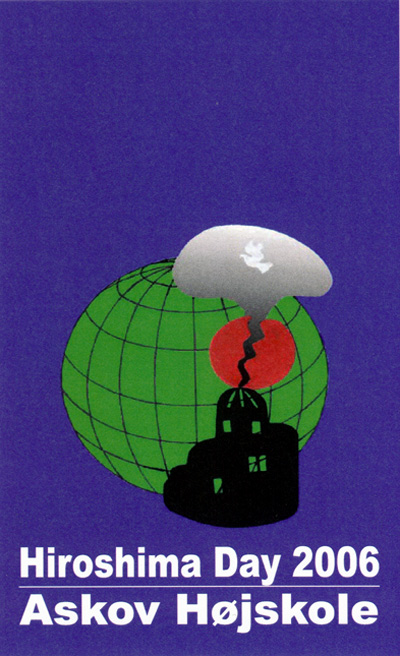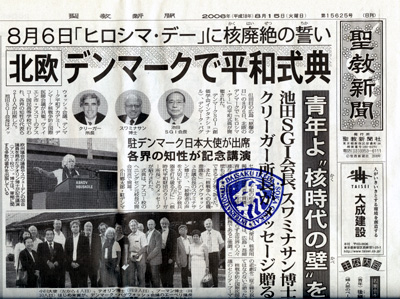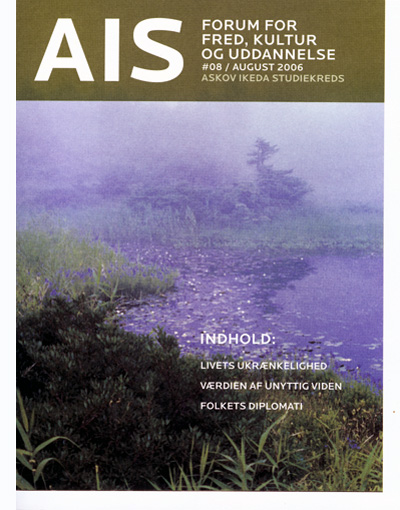Det danske Fredsakademi
Kronologi over fredssagen og international politik 6. August 2006 / Timeline August 6, 2006
Version 3.55. August 2006, 7. August 2006
08/06/2006 - 2007
Hiroshimadag
Amerikansk atombombe eksploderer
over den japanske by
Hiroshima, 1945.
 |
 |
 |
 |
 |
 |
 |

TENTATIVE PROGRAM FOR HIROSHIMA MEMORIAL DAY
ASKOV HØJSKOLE, MALTEVEJ 1, 6600 VEJEN, DENMARK
14.00-14.10: Welcome by the Principal of Askov Højskole
14.10-14.30: Message from Dr. Disaku Ikeda, President of SGI, read by Jan Møller
Message from Prof. M.S. Swaminathan, President of Pugwash, read by John Avery
Message from Dr. David Krieger, President of the Nuclear Age Peace Foundation, read by Tom Børsen
14.30-14.50: Renaissance Choir
14.50-15.15: Address by His Excellency Gotaro Ogawa, Ambassador of Japan to Denmark
15.15-15.40: Address by Caecilie Buhman, IPPNW.
15.40-16.10: Coffee break
16.10-16.25: Theatrical presentation
16.25-16.50: Address by Dr. Maj Britt Theorin, former Ambassador for Disarmament (Sweden), and former Member of the Swedish and European Parliaments.
16.50-17.00: Group singing
HIROSHIMA MEMORIAL DAY AT ASKOV COLLEGE IN DENMARK
By: John Avery
On August 6, 2006, the 61st anniversary of the tragic nuclear destruction of Hiroshima, an audience of 150 people assembled at Askov College in Jutland to listen to speeches and to draw lessons from the tragedy.
The memorial ceremony began with a welcome from the Principal of the college. This was followed by a message from Dr. Disaku Ikeda, the President of Soka Gakkai International, a 12-million-strong Buddhist organization devoted to culture, education and peace. Messages from Prof. M.S. Swaminathan, President of Pugwash Conferences on Science and World Affairs and from Dr. David Krieger, President of the Nuclear Age Peace Foundation, were also read to the group.
H.E. Ambassador Gotaro Ogawa then presented a major speech outlining Japan's renunciation of nuclear weapons and its efforts to promote peace and nuclear abolition through its foreign policy.
The next speaker was Caecilie Buhman, M.D., a young doctor from International Physicians for the Prevention of Nuclear War. Her Power Point presentation emphasized the necessity of educating a new generation to understand both the destructive power of nuclear weapons and individual responsibility in working for their abolition.
The final speaker was Dr. Maj Britt Theorin, former Disarmament Ambassador of Sweden and former member of the Swedish and European Parliaments. Her speech mentioned several hopeful examples, where NGO's succeeded in making major progress towards nuclear abolition. Among her examples were the recommendations of the Canberra Commission (later incorporated into the Final Document of the 2000 NPT Review Conference as the “13 Practical Steps”). Another example given by Dr. Theorin was the successful effort to have nuclear weapons declared to be illegal by the International Court of Justice.
A large number of the participants signed the INES appeal for the removal of US tactical nuclear weapons from Europe, (www.pugwash.eu).
A report of the meeting appeared on the front page of a Japanese newspaper, whose circulation is 5 million, so the message of the meeting reached a much larger audience than those present at the college. Hiroshima Memorial Day at Askov was sponsored by the Danish Pugwash Group, INES, IPPNW, the Danish Peace Academy and Soka Gakkai International.
Literature: Takuwa, Kazue: Øjenvidne beretning. Hiroshimadag på Askov Højskole d. 06. aug. 2006. [8 s.]
M S Swaminathan:
Hiroshima and Nagasaki serve as grim reminders of the enormous harm that can be caused to human survival by the abuse of science and technology. It reminds us of the urgent need to promote the cultures of scientific humanism and humanistic science. Hiroshima should become the flagship of the human quest for harmony with nature and with each other. I wish the Hiroshima Day organised by the Danish Pugwash Group great success in arousing consciousness of the perils of nuclear war.
M S Swaminathan
Chairman, National Commission on Farmers, Govt. of India
President, Pugwash Conferences on Science and World Affairs
Chairman, M S Swaminathan Research Foundation
Atombomber bør mindes
Helga Berg, Sejbjerg 18, Nørre Nissum, skriver om Hiroshima og Nagasaki dag 6. og 9. august:
Lemvig Folkeblad,
07. August 2006 12:00
http://www.lemvig-folkeblad.dk/apps/pbcs.dll/article?AID=/20060807/HOLSTEBRO/108070132/1083/lemvig
Atomvåben er også et kommunalt anliggende.
Det mener borgmesteren i Hiroshima. " Det er de lokale myndigheder, som i praksis skal udforme katastrofe-og evakueringsplaner. De lokale myndigheder har også et ansvar som sundhedsmyndigheder.. Alt dette påvirkes i allerhøjeste grad af risikoen for en atomvåben-eksplosion."
6. august er Hiroshima dag. "Little boy" eksploderede over byen. Og den 9.august 1945 kastedes "Fat boy" over Nagasaki. Siden har heldigvis ingen flere eksploderet, men der er nok af dem, og det har flere gange været lige ved, at nogle er blevet udløst.
I 1982 foreslog Hiroshimas daværende borgmester, at byer verden over dannede et netværk om et Program til fremme af kommunikation og solidaritet mellem byer med henblik på at fjerne atomvåben helt og holdent (Progamme to Promote the Solidarity of Cities toward the Total Abolition og Nuclear Weapons). Tanken har spredt sig, og nu er mere end 550 byer i 107 lande med i arbejdet.
Alle danske borgmestre fik 2004 et brev fra Danmarks Fredsråd med opfordring om at tilslutte sig. Det behøver ikke at koste kommunalbudgettet en øre. Det kan klares med e-post, til forskel fra venskabsbysamarbejdet. Det forventes dog, at oplysning om atomvåbenproblemerne og den lokale forståelse af vigtigheden heraf fremmes.
Her i Lemvig plejer vi jo ikke at mindes disse skrækkelige dage for over 60 år siden. Det kunne ellers være fint med flydende japanske lys på Lemvig sø...
|
|
|